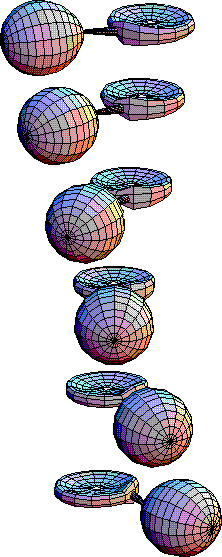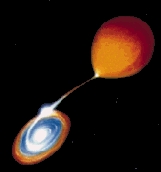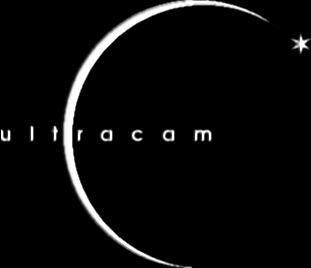
|
research (this page is very out of date!)
 what are cvs?
what are cvs?
 why study cvs?
why study cvs?
 background theory
background theory
 my interests
my interests
 ultracam
ultracam
|
what are cvs?
Of the 9000 stars visible to the naked eye from the Earth, well over
half consist of two or more bodies locked in gravitationally bound
orbits. About half of them, in turn, consist of interacting binary
systems where the two component stars are unable to complete their
normal evolution without being influenced by the presence of the
other. One of the classes of interacting binary are the cataclysmic
variables, or CVs, whose members include the novae, dwarf
novae and the novalikes. They consist of a white dwarf,
conventionally termed the `primary star', and a secondary, which is
typically a main-sequence star cooler than the Sun. These variables
are characterized by their `cataclysmic' (i.e. violent but
non-destructive) eruptions, which are associated with the presence of
an accretion disc around the primary star. The image above depicts
the five principal components of a typical cataclysmic variable: the
primary star (a white dwarf), the secondary star (a red dwarf), the
gas stream (formed by the transfer of material from the secondary to
the primary), the bright spot (formed by the collision between the gas
stream and the edge of the accretion disc), and the accretion disc.
The distance between the stellar components is approximately a Solar
radius and the orbital period is typically a few hours.
 back to top
back to top
why study cvs?
Cataclysmic variables provide a unique laboratory for the study of two
fundamental astrophysical processes: accretion and binary star
evolution. Accretion is the process by which matter is able to
overcome the angular momentum barrier which would normally prevent
material from spiralling inwards to form compact objects like the Sun,
the Earth, and black holes. Cataclysmic variable stars have been
central to many developments in the theory of accretion discs. This is
because the discs in these systems are nearby (and hence bright), they
evolve on very short timescales (hours to weeks) and using techniques
akin to medical tomography it is possible to probe structure
in the disc with micro-arcsecond angular resolution, resulting in the highest
resolution maps currently available in any branch of astrophysics.
(Note that the HST only achieves 0.05 arcsecond resolution.)
Binary star evolution
describes how two widely separated stellar companions may come
together and interact, leading to some of the most exotic inhabitants
of our Galaxy, such as the black-hole binaries, supernovae and perhaps
even the gamma-ray bursters. Cataclysmic variables are a vital link in
the evolutionary chain of binary stars, coming immediately after a
common-envelope phase and evolving via magnetic braking and
gravitational radiation - observations of cataclysmic variables have
played a key role in the development of these theories.
 back to top
back to top
background theory

|
When two stars come together to form a close binary system,
the gravitational fields of the two stars interact and become
distorted, as depicted in this image.
|

|
By plotting a contour map of the above image, we obtain the Roche
gravitational equipotentials. The surfaces close to the centre of each
star are spherical. Surfaces further and further from the stellar centres
become more and more distorted until we reach the critical surface,
which defines two cusped volumes, known as the Roche lobes. These
are indicated in this image by the figure-of-eight contour.
|

|
In three dimensions, the figure-of-eight potential defines a possible
surface for the stellar components, as illustrated in this figure.
|

|
When both stars are sufficiently small, each is within its Roche lobe
and is relatively undistorted. As the stars evolve, they expand
and gradually fill their potential wells. Eventually a point is reached when
one star has expanded to such an extent that its surface
is defined by the Roche lobe. Further expansion of the star (or, in
some close binaries, further contraction of the Roche lobe due to angular
momentum loss) results in a flow of material between the stars via the point
joining the two Roche lobes -
the inner-Lagrangian or L1 point. This process can be likened
to a rising water level in this plot of Roche
potential as a function of distance between the two stars - when the
right-hand well is full, the water will spill into the left-hand well.
|

|
The fate of the transferred mass can be modelled by computing particle
trajectories, as shown in this plot. As long as the initial velocities
of the particles are small, all the trajectories are more or less the same,
resulting in a well-defined gas stream between the two stars.
|

|
If one of the stars in a close binary is a white
dwarf, and the other is a star which is in contact with its Roche lobe,
then the system is known as a cataclysmic variable. The
transferred material forms a well defined gas stream which
eventually settles down into an accretion disc surrounding the
white dwarf. The accretion disc is the source of the cataclysmic eruptions
often observed in these objects. This movie shows the orbit of an eclipsing
cataclysmic variable, speeded up many hundreds of times.
|
 back to top
back to top
my interests
My research interests centre on the study of cataclysmic variables,
and in particular, their evolution and the study of their accretion discs.
I am also interested in astronomical instrumentation, and am currently
building ULTRACAM - an
ultra-fast, triple-beam CCD camera for studying astrophysics on the fastest
timescales - with Tom Marsh. Here are copies of some of my recent papers
and talks.

|

|

|

|

|
|
Click on this image to see my research-level talk on
Cataclysmic Variables, which I gave at various UK
universities in March/April 2000.
|
Click on this image to see my review talk on Imaging the
Secondary Stars in CVs, which I gave at the Astro-tomography workshop
in Brussels in July 2000.
|
Click on this image to see my popular-level talk on The Lives
of Binary Stars, which I gave to the Sheffield Astronomical Society
in November 2000.
|
Click on this image to see my talk on ULTRACAM, which I gave
at the ING in January 2001.
|
Click on this image to see my review talk on ULTRACAM, which I
gave at the First Galway Workshop on High Time Resolution Astrophysics
in April 2001.
|

|
THE NOVA-LIKE VARIABLES
Vik Dhillon
Invited review in: Cataclysmic Variables and Related Objects,
Proceedings of the 158th Colloquium of the IAU, A
Evans, J H Wood eds, Kluwer, Dordrecht, 1996, p. 3
We review optical observations and theoretical models of the
non-magnetic nova-like variables (UX UMa, VY Scl and SW Sex stars). A
brief discussion of the classification scheme is followed by a
statistical overview of the observed properties. The most important
features of each of the sub-classes are then reviewed, concluding with
a summary of the theoretical models invoked to understand these
systems.
|

|
INFRARED OBSERVATIONS OF CVs
Vik Dhillon
Invited review in: Wild Stars in the Old West: Proceedings of the
13th North American Workshop on CVs and Related Objects,
ASP Conference Series, Vol. 137, Steve Howell, Erik Kuulkers, Chick
Woodward eds, 1998, p. 132.
We review infrared (1-2.5 micron) observations of cataclysmic
variables, a relatively unexplored part of the spectrum in which the
dominant sources of emission are the secondary star, the outer regions
of the accretion disc and the accretion column in magnetic systems. We
describe the advances that have been made in our understanding of
cataclysmic variables based on infrared photometry and, more recently,
infrared spectroscopy and present spectra of each class of cataclysmic
variable - the dwarf novae, novalikes, polars and intermediate
polars.
|

|
IMAGING THE SECONDARY STARS IN CATACLYSMIC VARIABLES
Vik Dhillon, Chris Watson
Invited review in: Astro-tomography: An International Workshop on
Indirect Imaging, Brussels, July 2000, Henri Boffin, Danny Steeghs eds,
in press.
The secondary, Roche-lobe filling stars in cataclysmic variables (CVs)
are key to our understanding of the origin, evolution and behaviour of
this class of interacting binary. We review the basic properties of the
secondary stars in CVs and the observational and analysis methods
required to detect them. We then describe the various astro-tomographic
techniques which can be used to map the surface intensity distribution
of the secondary star, culminating in an detailed explanation of Roche
tomography. We conclude with a summary of the most important results
obtained to date and future prospects.
|

|
Click on this button for a list of (and links to) some of my other
research papers.
|
 back to top
back to top

 what are cvs?
what are cvs? why study cvs?
why study cvs? background theory
background theory my interests
my interests ultracam
ultracam
 what are cvs?
what are cvs? why study cvs?
why study cvs? background theory
background theory my interests
my interests ultracam
ultracam back to top
back to top back to top
back to top back to top
back to top back to top
back to top